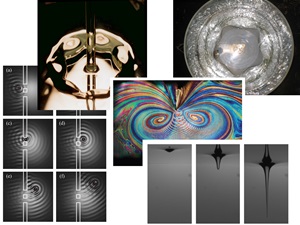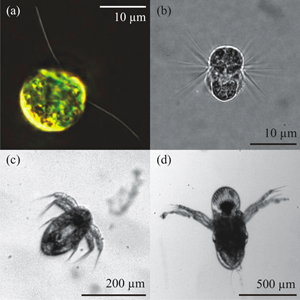Hydrodynamical instabilities in free surface flows
Supervisor: Anders Andersen and Tomas Bohr
Flows of water or other fluids can exhibit amazing instabilities, where the symmetry of the flow changes, vortices are created or corners/needles suddenly appear. In this project, we perform an experiment on a hydrodynamic flow with a free surface and look at the flow structure and possible instabilities both experimentally and theoretically. We can e.g., look at polygons forming in hydraulic jumps, or in rotating flows, at the formation of bathtub vortices or at drops bouncing/walking on fluid surfaces. Come and discuss with us, if you like water flows and want to understand them.

Images of free surface flows in a hydraulic jump, a rotating cylinder, a flapping foil in a soap film, a bathtub vortex and for a bouncing-walking drop.
Flows and fluid disturbances due to swimming microorganisms
Supervisor: Anders Andersen and Thomas Kiørboe
Plankton are small organisms that inhabit the oceanic water masses. They are faced with a dilemma: They need to swim to find food and mates, but by swimming they inevitably create flow disturbances that attract predators. Recently, it was shown that planktonic breast stroke swimmers can reduce the flow disturbances that they create in the water around them, simply by appropriately arranging their propulsion apparatus [Andersen et al. 2015]. In this project you will learn the theoretical model framework behind these results and apply the model ideas to explore and describe flows due to biologically important swimmers with different propulsion apparatus.

Examples of planktonic breast stroke swimmers: (a) Chlamydomonas reinhardtii, a flagellate (image by courtesy of Knut Drescher), (b) Mesodinium rubrum, a ciliate, (c) a nauplius (juvenile) of Acartia tonsa, a copepod, and (d) Podon intermedius, a cladoceran.